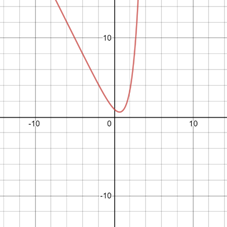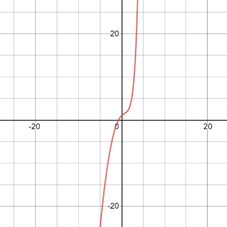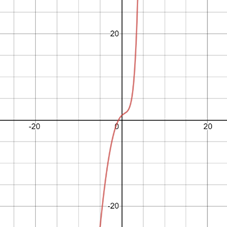
Concept explainers
a.
To graph: The equation
a.
Explanation of Solution
Given information:
The equation
Graph:
The graph of the equation

Interpretation:
The graph of equation
b.
To calculate: The antiderivative of the equation
b.
Answer to Problem 40E
The antiderivative of the equation

Explanation of Solution
Given information:
The equation is given as:
Formula used:
The function F is antiderivative of
Power rule:
Calculation:
Consider the equation,
The antiderivative of
So, by reverse power rule Integrating both sides of equation,
Therefore, integrating the function
Thus, the of the equation is
Now applying the condition
Put the value of
So, now using the graph device and the graph of antiderivative

c.
To calculate: The antiderivative of the equation
c.
Answer to Problem 40E
The antiderivative of the equation
Explanation of Solution
Given information:
The equation is given as:
Formula used:
The function F is antiderivative of
Power rule:
Calculation:
Consider the equation,
The antiderivative of
So, by reverse power rule Integrating both sides of equation,
Therefore, integrating the function
Thus, the of the equation is
d.
To graph: The equation
d.
Explanation of Solution
Given information:
The equation
Graph:
The graph of the equation

The graph of equation

Interpretation:
The graphs of equation
Then the graph of equation
Chapter 4 Solutions
Single Variable Calculus: Concepts and Contexts, Enhanced Edition
 Calculus: Early TranscendentalsCalculusISBN:9781285741550Author:James StewartPublisher:Cengage Learning
Calculus: Early TranscendentalsCalculusISBN:9781285741550Author:James StewartPublisher:Cengage Learning Thomas' Calculus (14th Edition)CalculusISBN:9780134438986Author:Joel R. Hass, Christopher E. Heil, Maurice D. WeirPublisher:PEARSON
Thomas' Calculus (14th Edition)CalculusISBN:9780134438986Author:Joel R. Hass, Christopher E. Heil, Maurice D. WeirPublisher:PEARSON Calculus: Early Transcendentals (3rd Edition)CalculusISBN:9780134763644Author:William L. Briggs, Lyle Cochran, Bernard Gillett, Eric SchulzPublisher:PEARSON
Calculus: Early Transcendentals (3rd Edition)CalculusISBN:9780134763644Author:William L. Briggs, Lyle Cochran, Bernard Gillett, Eric SchulzPublisher:PEARSON Calculus: Early TranscendentalsCalculusISBN:9781319050740Author:Jon Rogawski, Colin Adams, Robert FranzosaPublisher:W. H. Freeman
Calculus: Early TranscendentalsCalculusISBN:9781319050740Author:Jon Rogawski, Colin Adams, Robert FranzosaPublisher:W. H. Freeman
 Calculus: Early Transcendental FunctionsCalculusISBN:9781337552516Author:Ron Larson, Bruce H. EdwardsPublisher:Cengage Learning
Calculus: Early Transcendental FunctionsCalculusISBN:9781337552516Author:Ron Larson, Bruce H. EdwardsPublisher:Cengage Learning





